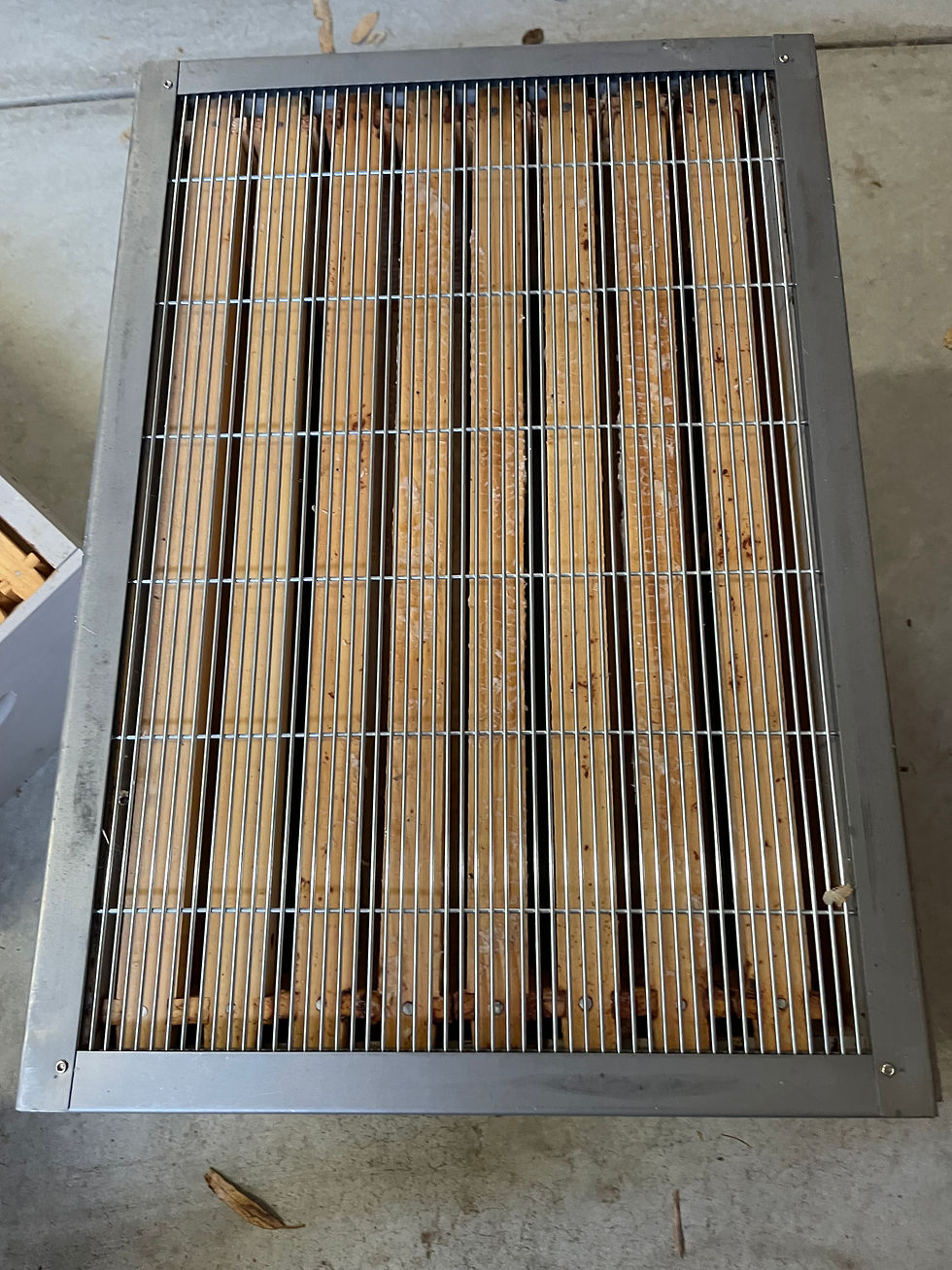The Basics of a Beehive
- parkerspurehoney
- Sep 29, 2022
- 4 min read
Hi there! In this post I’ll be talking about what a beehive is made up of, giving you an update on what’s happening in our beehive and, as I promised last post, answering some questions that I one of my subscribers has asked.
When you purchase a beehive you purchase four boxes, a queen excluder, a lid, a base, and generally 32 frames. You may not need all the frames and boxes all the time but you purchase them so that in summer you can add as many boxes as you want without having to worry about running out of boxes or frames.
At the bottom of a beehive you have a base. The base is what the boxes sit on and what stops
bees spilling out the bottom of the hive. Above that you have your first brood box.
There are two types of boxes that are exactly the same in design but their purpose is completely different. The brood boxes are at the bottom. They are under the queen excluder so the queen can lay her eggs in here. The workers will also store some pollen and nectar on the outer frames. This is where you inspect if you want to check for disease and check on the health of the brood (brood is a term that refers to developing bees in their cells).
The next type of box is a honey super (or just super for short). A super is above the queen excluder so the queen cannot access it to lay her eggs as she is too big to squeeze through the grill. This is where you can harvest the honey from. The workers will fill these boxes purely with mature honey or developing honey and not pollen or other substances.
Finally, you have the lid. As probably indicated in the name the lid is just a topper that stops the bees from accessing the hive through through the roof and protecting the hive from the elements.

This picture shows the parts of the beehive (up to two supers can be added, this picture only showing one)
Note: a lid is not pictured in this photo

This picture shows the queen excluder on top of an empty box of frames. (notice the grill that allows worker bees to get through but not the queen)
Q: How often do you harvest the honey?
A: Honey is seasonal. You can only really harvest in the spring and summer. This is because the amount of food available to the bees changes throughout the year. In spring and summer there is more food so the bees expand into the supers and you can harvest. The amount of honey that we harvest each year varies depending on if it is a good year or not. Last year was a pretty good year we harvested twice once in March and once in December both times giving us around 15kg of honey summing us up to about 30kg of honey.
Q: How many bees to you have?
A: The amount of bees in a hive greatly relies on two factors. The season and the age of the hive. As explored in the first question the strength of the hive is greatly dependent on the time of year. When it is summer there will almost always be more bees in the hive than when it is in the winter. Now lets look at the second point. If you just got your hive your going to have less bees than a hive that's been running for, say, a year.
Q: Are bees hard to look after?
A: Overall bees are pretty self sustaining. My default routine is to try to inspect the hive once every three weeks. This does change for instance over winter we don't want to open the hive up and freeze the brood and in spring we would inspect it a bit more if possible to check for signs of swarming. (If you don't know what swarming is then you can check out my first post by using the button below)
Q: Have you ever been stung by a bee?
A: In this question I assume that you mean while beekeeping have you ever been stung and the answer is yes. A couple times actually. There are really two types of stings you can get when beekeeping dry stings, and real stings. A real sting is what you may have experienced before where a bee stings you and injects a small amount of venom that causes the area around the sting site to hurt and swell up. This is what normally happens when you get stung by a bee. A dry sting on the other hand is where the sting pierces the skin but not far enough that it injects venom because it is stopped by something like a bee suit or thick jeans. These are the stings I get when beekeeping. They only hurt for a few seconds and then go away, unnoticeable. This is more like very lightly prodding yourself with a pin on the leg. It is definitely not bad and is bearable so that you can continue the inspection. I have got a real sting once when beekeeping, through the sock, which wasn't good.
Our bees are going pretty good, last Sunday we did an inspection in which we split the hive to make two new smaller hives. This means we can make more honey and hopefully keep up with the supply demand curve when it comes to summer. The wildflowers are out and truly booming which will be good for getting out new hives started and producing
Make sure to check your inboxes for an email inviting you to ask some questions. Stay safe and happy September!
- Parker's Pure



Comments